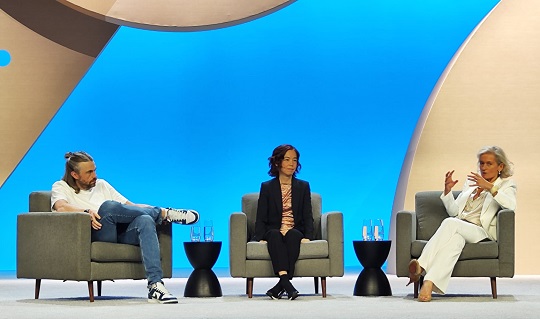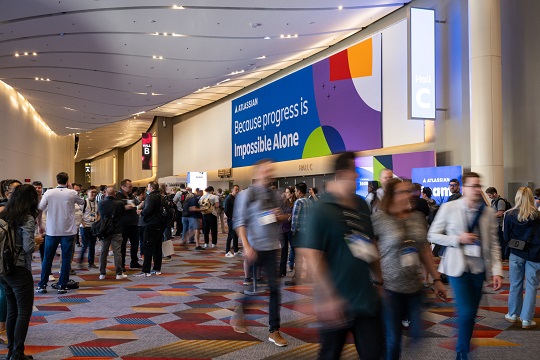Atlassian Team ‘24: AI as a teammate in the 'new compute' era
Atlassian used its Team ‘24 conference and exhibition to showcase a wide range of enhancements and extensions to its team collaboration, productivity software and service management platform.
Held in Las Vegas at The Venetian & Palazzo this May 2024, the Computer Weekly Developer Network team attended the opening keynote entitled ‘unleashing the potential of every team with AI’ presented by Mike Cannon-Brookes, Atlassian co-founder & co-CEO, Zanny Minton Beddoes, editor-in-chief of The Economist and Dr. Fei-Fei Li, an expert in AI.
According to the company’s event statement, “Atlassian Team 24 is more than just a conference; it’s a convergence of minds, ideas, and technologies designed to empower teams across the globe.”
This year’s agenda was (like so many others in enterprise software) heavily loaded with AI sessions. The event’s sessions were split out across various topics, including product demos, case studies and technical sessions.
AI as your teammate
The conference itself was staged around a set of six cornerstone technology functions, practices and methodologies that Atlassian uses to express where the heart of its products are focused. Those core elements are: AI as your teammate; cloud and data centre transformations, cross-functional collaboration, developer experience, enterprise agility at scale; and high-velocity service management
The company used AI as teammate sessions to explain how integrating AI across Atlassian’s product suite is promised to boost speed, efficiency and quality. The company also focused on strategies to effectively connect team, project, product and portfolio structures, enhancing planning, investment, adaptability and value delivery.
Speaking in the opening keynote panel, Cannon-Brookes said that, “Workplace transformation is on show at ‘Team 24 and hopefully all attendees will go away having learned some really valuable hands-on use case lessons. With AI being behind one of the biggest workplace shifts in history, our speakers have much to tell us about the transformations happening now.”
Minton Beddoes (Zanny to her friends) said that she has been following the development of AI throughout the last decade. When it comes to how we talk about AI, she’s not keen on government administrators talking about AI in the sense of Terminator-style dystopias – that’s not helpful she advises.
AI is the ‘new compute’
“I like to think of AI as the ‘new compute’ … and as AI now becomes multi-modal, AI is becoming a reasoning engine that we can attach to any chip,” she said. Zanny also noted that she herself has spoken to Sam Altman recently and they agreed that, when the point comes we reach Artificial General Intelligence (AGI) the world will go ‘what the hell? [is happening]’ for three weeks and then we’ll all get on with life.”
From her perspective, when we really start to see widespread ‘diffusion’ of AI into tools that are in literally everybody’s hands – then we will start to consider AI in different ways.
Dr. Fei-Fei Li said that, in terms of how AI is going to be applied today, if there is a chip in it (any device as small as a light bulb) then there will be AI in it.
“Starting from a basic logic gate, we can now build AI upwards to become so much more sophisticated. When we first coined the term AI back in 1959, it was inspired by an imagination that wanted to be able to build thinking machines. Back when I first started working in AI 20+ years ago, I came to it just like any curious scientist when I was a physics student in college – and that was point when I realised it was important to ask detailed questions of the smallest things in the universe. So I wanted to understand what is machine intelligence – and indeed, what is human intelligence. But even today, I think AI is still as whimsical as it was when we started,” said Dr Li.
She also suggested that sometimes – as technologists – it’s tough to see the inflexion point when technologies start to really evolve, so really we can also say that ChatGPT was a way for non-technical people to witness the inflexion point of AI as they were able to get their hands on it.
Is it a feature or bug?
Canon-Brookes brought the conversation around to the fact that humans are perhaps unsettled by AI’s ability to produce unexpected outputs. We know that statistical models have unexpected behaviour and undefined outcomes and sometimes (if we are at such an embryonic stage with these technologies) we question whether an output is a feature of a bug?
Scott Farquar also presented during what constituted as this event’s day-2 morning keynote. Talking through Jira Product Discovery, he noted the arrival of a new premium version of this product with additional standard template functions, as well as newer AI enhancements which help to make the product itself capable of being used without any training being required. Some 7000 customers have used this product to collaborate on what Atlassian says is a total of 3-million ideas thus far.
Loom: an asynchronous video tool
With so much developer coding time spent on code requirements, testing for bugs and providing feedback to other members of the team. Farquar says this is why Atlassian has now provided its asynchronous video tool Loom for software engineers – Loom for Developers is hoped to speed up many of these tasks.
Compass was also showcased. Compass is a developer portal that provides a unified real-time representation of the engineering output in one place. Atlassian Compass helps developers track the things your engineering teams build — we call these components. It naturally complements Jira, which tracks the effort of an engineering team in building those components.
Farquar also covered the current state of Jira Service Management. With Jira Service Management, users can receive, track, manage and resolve requests from the team’s customers. Customers can send requests by email, a customisable help centre and an embeddable widget.
Finally (actually not finally, there were several other product and tool overviews, but let’s say finally for now) the audience received updates on Atlassian Guard Premium, software designed to defend priority projects with the company’s most advanced security capabilities and stop threats before they become incidents.
Key takeaways
The key takeaways are clear to see here.
This is Atlassian being more vocal, more directly connected with press & analysts and more expansive in terms of its technology platform ambitions. Significantly, it’s also Atlassian being the collaboration tools company, the project management company, the IT service management company and the developer tools company. Rajeev Rajan, chief technology officer, Atlassian has said that he is now focused on building out what he refers to as a ‘world class’ software engineering team of people working at all levels of technology as the firm also strives to reinforce its brand and – in quite basic terms – be seen as an even bigger player in the enterprise software space.






